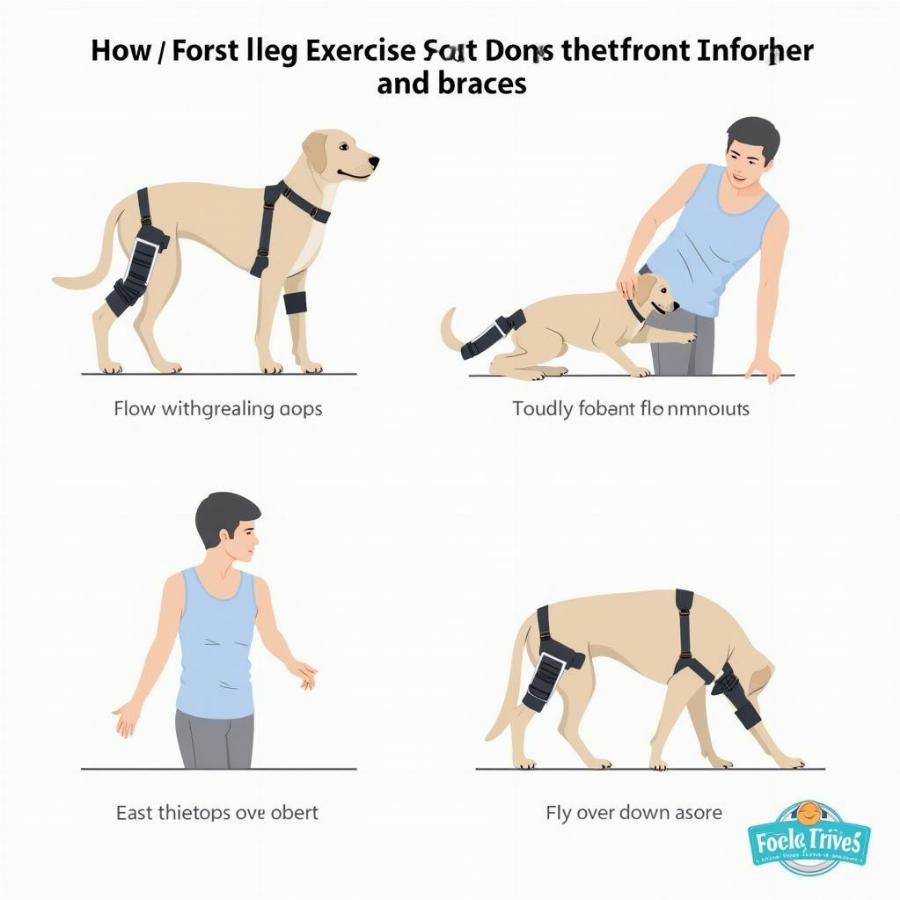Elbow dysplasia is a common and painful condition affecting many dogs, particularly larger breeds. Front leg braces for dogs with elbow dysplasia offer a non-surgical approach to managing this debilitating disease, providing support and stability to reduce pain and improve mobility. Understanding the benefits, types, and proper usage of these braces is crucial for dog owners seeking to improve their furry friends’ quality of life. Let’s dive deep into the world of front leg braces and discover how they can help your canine companion cope with elbow dysplasia.
Understanding Elbow Dysplasia in Dogs
Elbow dysplasia is a developmental disorder characterized by abnormal growth of the bones forming the elbow joint. This can lead to joint incongruity, cartilage damage, and eventually osteoarthritis. Symptoms often appear in young dogs, usually between four and ten months of age, and include lameness, stiffness, pain, and decreased range of motion.
Causes and Symptoms of Elbow Dysplasia
Several factors contribute to the development of elbow dysplasia, including genetics, rapid growth, improper nutrition, and excessive exercise during puppyhood. If your dog exhibits any of the symptoms mentioned above, it’s vital to consult a veterinarian for a proper diagnosis.
How Front Leg Braces Help Dogs with Elbow Dysplasia
Front leg braces for dogs with elbow dysplasia provide support and compression to the affected joint, helping to stabilize the joint, reduce inflammation, and alleviate pain. They also help improve joint function by limiting abnormal movement and promoting proper alignment.
Types of Front Leg Braces for Dogs
Various types of front leg braces are available, ranging from simple sleeves to custom-made orthoses. The choice of brace depends on the severity of the dysplasia, the dog’s size and activity level, and the veterinarian’s recommendation.
Choosing the Right Brace for Your Dog
Selecting the appropriate brace can be daunting. Consider factors like the brace’s material, design, and level of support. A well-fitting brace should be comfortable, secure, and not restrict the dog’s movement excessively.
Fitting and Adjusting a Front Leg Brace
Proper fitting is crucial for the brace’s effectiveness. Follow the manufacturer’s instructions carefully and consult your veterinarian for guidance. Adjustments might be needed as your dog grows or the condition progresses.
Caring for Your Dog with a Front Leg Brace
Maintaining the brace’s cleanliness and monitoring your dog’s skin for irritation are essential. Regularly inspect the brace for wear and tear and replace it when necessary.
Exercise and Activity with a Front Leg Brace
While a brace helps manage dysplasia, it doesn’t eliminate the need for controlled exercise. Consult your veterinarian for a suitable exercise plan that promotes joint health without overexertion.
What are the signs my dog needs a front leg brace for elbow dysplasia?
If your dog shows signs of lameness, stiffness, pain when bending the elbow, or difficulty getting up, these could indicate the need for a brace. A vet can diagnose the condition and recommend the best course of action.
Can my dog sleep with a front leg brace?
Whether a dog can sleep with a brace depends on the type of brace and the dog’s comfort level. Some braces are designed for continuous wear, while others are best removed during rest. Consult your veterinarian for advice specific to your dog’s situation.
Are front leg braces a long-term solution for elbow dysplasia?
Braces are a management tool, not a cure. They can significantly improve a dog’s comfort and mobility, but the underlying dysplasia remains. Long-term management may involve a combination of bracing, medication, physical therapy, and weight management.
How much do front leg braces for dogs cost?
The cost of braces varies depending on the type, size, and whether it’s custom-made. Simple sleeves can cost less than custom-made orthoses, which can be considerably more expensive.
 Rehabilitation Exercises for Dogs Wearing a Front Leg Brace
Rehabilitation Exercises for Dogs Wearing a Front Leg Brace
Conclusion
Front leg braces for dogs with elbow dysplasia offer a valuable tool in managing this painful condition. They provide support, reduce pain, and enhance mobility, ultimately improving the dog’s quality of life. By understanding the different types of braces, selecting the right fit, and incorporating proper care and exercise, you can help your canine companion live a more comfortable and active life despite this challenging condition. Remember to consult with your veterinarian for a personalized treatment plan.
FAQ
- Are front leg braces effective for all stages of elbow dysplasia? Braces can be beneficial for various stages, but their effectiveness may vary.
- Can my dog swim with a front leg brace? Most braces are not designed for swimming; consult your veterinarian.
- How long does it take for a dog to adjust to a brace? Adjustment time varies; patience and positive reinforcement are crucial.
- Are there any alternatives to front leg braces? Other options include medication, physical therapy, and surgery.
- Can a brace prevent the progression of elbow dysplasia? While a brace can help manage symptoms, it doesn’t prevent disease progression.
- What are the signs that a brace doesn’t fit correctly? Signs include redness, sores, excessive licking, and changes in gait.
- How often should I clean my dog’s front leg brace? Follow manufacturer instructions; regular cleaning is important to prevent skin irritation.